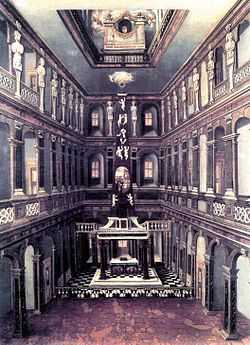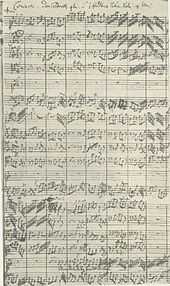Bereitet die Wege, bereitet die Bahn! BWV 132

Bereitet die Wege, bereitet die Bahn! (Prepare the paths, prepare the road!),[1] BWV 132, is a church cantata by Johann Sebastian Bach. He wrote it in Weimar in 1715 for the fourth Sunday in Advent and first performed it on 22 December 1715.
History and words
On 2 March 1714 Bach was appointed concertmaster of the Weimar court capelle of the co-reigning dukes Wilhelm Ernst and Ernst August of Saxe-Weimar. As concertmaster, he assumed the principal responsibility for composing new works, specifically cantatas for the Schlosskirche (palace church), on a monthly schedule.[2] He wrote this cantata for the fourth Sunday in Advent,[3] dating it himself.
The prescribed readings for the Sunday were from the Epistle to the Philippians, "Rejoice in the Lord alway" (Philippians 4:4–7), and from the Gospel of John, the testimony of John the Baptist (John 1:19–28). The cantata text was written by the court poet Salomon Franck and included the fifth verse of the chorale "Herr Christ, der einig Gotts Sohn" (1524) of Elisabeth Cruciger.[4] The cantata text was published in 1715 in Evangelisches Andachts-Opffer. Franck paraphrases in the first aria Isaiah 40:3–4, mentioned in the gospel, "Bereitet dem Herrn den Weg" (Prepare the path for the Lord), the same words which open Handel's Messiah. Franck also refers to the baptism. The individual Christian is addressed as a limb of Christ.[5]
Bach first performed the cantata on 22 December 1715 in the ducal chapel,[3]
Scoring and structure
As in several other cantatas on words of Franck, the cantata is scored for a small ensemble, here soprano, alto, tenor, and bass, two oboes, two violins, viola and basso continuo. A choir is only needed for the chorale, if at all. The music of the chorale is lost; it may have been noted in a simple setting on a separate sheet, as in the similar case of Nur jedem das Seine, BWV 163, composed four weeks earlier. For practical purposes the same verse, closing Ihr, die ihr euch von Christo nennet, BWV 164, in 1725, may be used.[5][6] The cantata is structured in six movements.
- Aria (soprano): Bereitet die Wege, bereitet die Bahn!
- Recitative (tenor): Willst du dich Gottes Kind und Christi Bruder nennen
- Aria (bass): Wer bist du? Frage dein Gewissen
- Recitative (alto, strings): Ich will, mein Gott, dir frei heraus bekennen
- Aria (alto, violin): Christi Glieder, ach bedenket
- Chorale: Ertöt uns durch deine Güte
Music

The first aria is in da capo form in a swinging 6/8 time signature, accompanied by the full ensemble.[7] The soprano calls in melismas of several measures of semiquavers.[3] The oboe adds virtuoso figuration and trills, reminiscent of Bach's secular music. The aria is concluded by rejoicing calls: "Messias kömmt an" (The Messiah arrives).[5]
The tenor recitative contains extended arioso passages, to stress "der Christen Kron und Ehre" (the Christians' crown and glory) [1] and "Wälz ab die schweren Sündensteine" (back the heavy stones of sin).[1] The voice and the continuo are at times set in imitation, an image for the Nachfolge (following), as they go together to express the unity achieved, on the words "daß er mit dir im Glauben sich vereine" (so that He may unite Himself to you in faith).[1][3]
In the bass aria the question "Wer bist du?" (Who are you?),[1] posed by the priests to St. John in the gospel, is given to the bass as the vox Christi, as if Jesus asked the listener this question. The first motive in the cello expresses the question and is repeated throughout the movement, and the vocal line is derived from it.[5]
The expressive declamation of the alto recitative is highlighted by chords in the strings. A solo violin accents the following aria, possibly inspired by the words "Christus gab zum neuen Kleide roten Purpur, weiße Seide" (Christ gave as new garments crimson robes, white silk).[1][5] John Eliot Gardiner interprets it as "the cleansing effect of baptismal water".[3] The musicologist Julian Mincham supports that, stating: "Bach seldom neglects opportunities of creating musical images of cleansing water when mention is made of the act of baptism. This is the starting point of his invention of the violin obbligato melody".[7]
The four-part setting of the closing chorale[8] can be taken from Ihr, die ihr euch von Christo nennet, BWV 164.[5]
Recordings
- J.S. Bach: Cantatas BWV 61 & BWV 132, Helmut Kahlhöfer , Kantorei Barmen-Gemarke , Deutsche Bachsolisten, Ingeborg Reichelt, Hildegard Rütgers, Theo Altmeyer, Eduard Wollitz , Cantate 1966
- Bach Cantatas Vol. 1 – Advent and Christmas, Karl Richter, Münchener Bach-Chor, Münchener Bach-Orchester, Edith Mathis, Anna Reynolds, Peter Schreier, Theo Adam, Archiv Produktion 1972
- Die Bach Kantate Vol. 60, Helmuth Rilling, Gächinger Kantorei, Bach-Collegium Stuttgart, Arleen Augér, Helen Watts, Kurt Equiluz, Wolfgang Schöne, Hänssler 1977
- J.S. Bach: Das Kantatenwerk – Sacred Cantatas Vol. 7, Gustav Leonhardt, Knabenchor Hannover, Collegium Vocale Gent, Leonhardt-Consort, Sebastian Hennig (soloist of the Knabenchor Hannover), René Jacobs, Marius van Altena, Max van Egmond, Teldec 1983
- J.S. Bach: Complete Cantatas Vol. 2, Ton Koopman, Amsterdam Baroque Orchestra & Choir, Barbara Schlick, Kai Wessel, Christoph Prégardien, Klaus Mertens, Antoine Marchand 1995
- J.S. Bach: Cantatas Vol. 7, conductor Masaaki Suzuki, Bach Collegium Japan, Ingrid Schmithüsen, Yoshikazu Mera, Makoto Sakurada, Peter Kooy, BIS 1997
- Bach Cantatas Vol. 13: Köln/Lüneburg, conductor John Eliot Gardiner, Monteverdi Choir, English Baroque Soloists, Brigitte Geller, Michael Chance, Jan Kobow, Dietrich Henschel , Soli Deo Gloria 2000
- J.S. Bach: Cantatas for the Complete Liturgical Year Vol. 9, Sigiswald Kuijken, La Petite Bande, Gerlinde Sämann, Petra Noskaiová, Christoph Genz, Jan van der Crabben, Accent 2008
References
- ↑ 1.0 1.1 1.2 1.3 1.4 1.5 Dellal, Pamela. "BWV 132 – Bereitet die Wege, bereitet die Bahn". Emmanuel Music. Retrieved 20 December 2014.
- ↑ Koster, Jan. "Weimar 1708–1717". let.rug.nl. Retrieved 16 December 2011.
- ↑ 3.0 3.1 3.2 3.3 3.4 Gardiner, John Eliot (2010). "Cantatas for the Fourth Sunday in Advent / Michaeliskirche, Lüneburg" (PDF). bach-cantatas.com. p. 5. Retrieved 11 December 2010.
- ↑ "Herr Christ, der einge Gottes Sohn / Text and Translation of Chorale". bach-cantatas.com. 2009. Retrieved 10 December 2012.
- ↑ 5.0 5.1 5.2 5.3 5.4 5.5 Dürr, Alfred (1981). Die Kantaten von Johann Sebastian Bach (in German) 1 (4 ed.). Deutscher Taschenbuchverlag. pp. 104–106. ISBN 3-423-04080-7.
- ↑ Leonard, James. "Cantata No. 132, "Bereitet die Wege, bereitet die Bahn," BWV 132". Allmusic. Retrieved 11 December 2010.
- ↑ 7.0 7.1 Mincham, Julian (2010). "Chapter 67 BWV 132 Bereitet die Wege, bereitet die Bahn! / Prepare the paths and byways!". jsbachcantatas.com. Retrieved 11 December 2010.
- ↑ "Chorale Melodies used in Bach's Vocal Works / Herr Christ, der einge Gottes Sohn". bach-cantatas.com. 2008. Retrieved 10 December 2012.
Sources
- Bereitet die Wege, bereitet die Bahn, BWV 132: Scores at the International Music Score Library Project
- Bereitet die Wege, bereitet die Bahn BWV 132; BC A 6 / Sacred cantata Leipzig University
- Cantata BWV 132 Bereitet die Wege, bereitet die Bahn: history, scoring, sources for text and music, translations to various languages, discography, discussion, Bach Cantatas Website
- BWV 132 Bereitet die Wege, bereitet die Bahn: history, scoring, Bach website (German)
- BWV 132 Bereitet die Wege, bereitet die Bahn: English translation, University of Vermont
- BWV 132 Bereitet die Wege, bereitet die Bahn: text, scoring, University of Alberta
External links
- Bereitet die Wege, bereitet die Bahn, BWV 132: performance by the Netherlands Bach Society (video and background information)
| ||||||||||
|